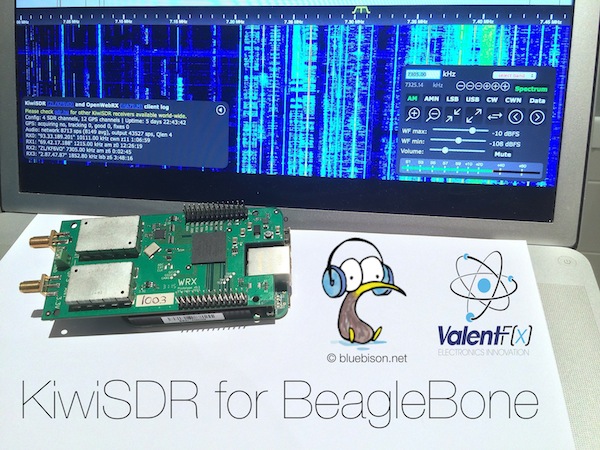
KiwiSDR – SOFTWARE-DEFINED RADIO (SDR) CAPE FOR THE BEAGLEBONE

WHAT IS KiwiSDR?
KiwiSDR is a software-defined radio (SDR) covering shortwave, the longwave & AM broadcast bands, various utility stations, and amateur radio transmissions, world-wide, in the spectrum from 10 kHz to 30 MHz. The KiwiSDR is a custom circuit board (cape) you attach to a BeagleBone Black or Green. Add an antenna, power supply, internet connection, then install the software package and be running in minutes.
An HTML5-capable browser and internet connection will let you listen to a public KiwiSDR anywhere in the world. Up to four people can listen simultaneously to one receiver -- each listener tunes independently.
TRY IT ONLINE RIGHT NOW
Click to listen to a test site in Sweden, Canada or New Zealand:
New KiwiSDR receivers will be listed on the sdr.hu website.
WHY DID WE BUILD IT?
Sure, the world doesn't really need another SDR. But we haven't found one with this set of features. In cost and performance, KiwiSDR fits between RTL-SDR USB dongle-style, or fixed DDC chip devices ($20 - $400, 8-12 bit ADC, limited bandwidth), and full 16-bit SDRs ($700 - $3500) while offering better wide-band, web-enabled capabilities than the more expensive SDRs.
APPLICATIONS
In addition to listening to shortwave radio, KiwiSDR is a fantastic way to learn the practical details of SDR and GPS design. We strongly encourage you to pull apart the code and firmware to see how things work. Find a bug or have a better way to implement something? Great! Please let us know.
Our main motivation is to enable new applications which utilize a significant number of programmable, web-accessible SDRs world-wide. Direction finding remains one of the great under-solved problems of shortwave listening, particularly for utility stations. Given the GPS timing available on the KiwiSDR, could time-of-arrival techniques between cooperating SDRs be used? We'd sure like to find out.
Also, we'd like to see data decoders built directly into the web interface of KiwiSDR. There are many standalone programs that demodulate and decode data signals from SDRs. But these are computer- and OS-specific and often require a complicated interface to the data stream from the SDR. For example, we have a prototype of a WSPR decoder that is integrated into the KiwiSDR interface.
We plan on creating APIs to make it easier to develop applications for KiwiSDR.
FEATURES:
-
Browser-based interface allows up to 4 simultaneous user web connections per KiwiSDR.
-
Each connection tunes an independent receiver channel over the entire spectrum.
-
Waterfall display tunes independently of audio and includes zooming and panning.
-
100% Open Source / Open Hardware / Open PCB.
-
Extra attention paid to VLF/LF performance.
-
Automatic frequency calibration via received GPS timing.
-
Easy hardware and software setup.
-
Browser-based configuration interface.
HARDWARE:
-
Compatible with BeagleBone Black/Green cape specification.
-
Multi-channel, parallel DDC design using bit-width optimized CIC filters.
-
Linear Technology 14-bit, 65 MHz ADC.
-
Xilinx Artix-7 A35 FPGA, programmed from the Beagle.
-
Integrated 12-channel software-defined GPS receiver.
-
Skyworks SE4150L GPS front-end.
SOFTWARE:
-
Web interface based on OpenWebRX from Andras Retzler, HA7ILM.
-
Integrated software-defined GPS receiver from Andrew Holme's Homemade GPS Receiver.
-
Simple build environment. Recompiles on Beagle from clean in two minutes.
-
Beagle server-side written in C/C++, Javascript on the browser, Verilog for the FPGA.
-
Automatically starts when the Beagle (re)boots.
-
Optional automatic software updates over the network.
-
Configuration and admin settings accessed through browser interface or text files.
-
ADPCM audio and waterfall compression to minimize required network bandwidth.
-
All sources are on Github.
RESOURCES
Detailed information is contained in our 60-page design review document.
Website with development history.
KiwiSDR forum.
C/C++/Verilog source code, schematics, PCB layout (KiCAD) and BOM all on Github.
Purchase
The KiwiSDR is now available on KiwiSDR.com


